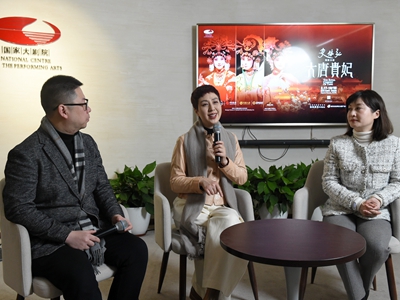On February 17th-19th, the Shanghai jingju Theatre Company’s new edition of the Peking opera Tang Concubines, starring famous Peking Opera artists from the Shanghai jingju Theatre Company, including SHI Yihong, LI Jun and XI Zhonglu, will embark on its Beijing premiere at the NCPA. On February 14th, SHI Yihong, the leading actress in this opera, attended a press conference with WANG Shujin, a doctor of art history, WANG Wei, Head of the Performance Department, NCPA, and NAN Hao, Performance Planner, NCPA. They interpreted the eternal love depicted in the opera, and shared their stories behind the curtain.

SHI Yihong disclosed details about starring in Tang Concubines with MEI Baojiu and LI Shengsu 20 years ago. At that time, MEI Baojiu rehearsed Tang Concubines in Shanghai with his cherished desire to inherit and innovate it. After selecting highlights from four volumes of Imperial Concubine YANG, he blended contemporary elements with the tradition by adding a variety of artistic forms to the opera, including Western opera, dance and symphony. Ode to Pear Blossom, the theme song of Dr. Youlin Ye Diploma Concert, a Peking opera featuring Siping tune, is also characterized by the singing style of the MEI School and easy to sing. It’s a bridge by which many people have gotten to know and lost their hearts to Peking Opera.

SHI Yihong
In 2019, the Shanghai jingju Theatre Company produced a new version of the Peking opera Tang Concubines by rearranging the original plot with The Drunken Concubine deleted, further burnishing the dramatic image of the opera and the mental state of the characters. Moreover, SHI Yihong acts differently in Scene 3 Pear Orchard, where Imperial Concubine YANG dances on the flat floor in the old version. Instead, SHI Yihong has worked with dancers HUANG Doudou and GAO Xiaoya by integrating classical dancing movements and traditional operatic elements into the dance by referring to the stage photos of Mr. MEI Lanfang’s Imperial Concubine YANG. They reproduced the jade-plate dancing and demonstrated the artistic characteristics of the MEI School along with singing and dancing. The dance is another highlight of the opera.
The multimedia imaging technique is used in the new edition to blend the traditional artform with modern science and technology, giving full play to the vividness and flexibility of the traditional Chinese opera art. In terms of music, the inherent features of Peking Opera art find more expression in magnificent and elegant stage scenes, interpreting this legendary and epic-like historical tragedy with a much more coherent musical emotion.
 Repertoire
Repertoire
 Films
Films
 Videos
Videos
 Podcast
Podcast
 China NCPA Orchestra
China NCPA Orchestra
 China NCPA Chorus
China NCPA Chorus
 NCPA Resident Singers
NCPA Resident Singers
 NCPA Drama Ensemble
NCPA Drama Ensemble
 Buildings
Exhibitions
Buildings
Exhibitions
 Opening Hours
Guided Tours
Services
Getting Here
Opening Hours
Guided Tours
Services
Getting Here
 Western Cuisine
NCPA Café
Arts Gifts
Western Cuisine
NCPA Café
Arts Gifts




























